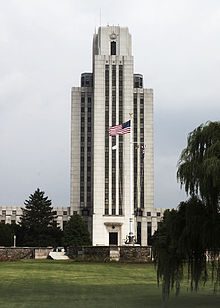Krutika Parasar
New Jersey, United States
 |
| Walter Reed National Military Medical Center |
In February 2007 a highly damaging scandal shook the renowned Walter Reed Army Medical Center to its very foundations. In a series of articles about the facility, the Washington Post reported deplorable infrastructure and unsanitary conditions in outpatient rooms and bureaucratic delays resulting in inefficiency and abandonment of soldiers.1 The revelation of dilapidated and vermin-infested facilities shocked readers and led to calls for reform. Amidst the clamor for righteousness and the resignation of several high ranking officials,1 the renovated Walter Reed National Military Medical Center (WRNMMC) was born. Every day thousands of U.S. soldiers dedicate their lives to their country. In the early twentieth century, medical facilities were created to care for those who bravely protect their fellow citizens.
The original ten-bed Walter Reed Army Medical Center was founded in 1909 in Fort McNair, and the Naval Medical Center was established in Bethesda in 1939.2 Both facilities had hospitals, medical training programs, museums, and medical libraries.2 During war, the facilities were greatly expanded in order to accommodate the wounded warriors.3 Such expansion led to new grants and extensions, but also resulted in more run-down facilities that sparked the movement for reform. A 2007 Congressional Reserve Service (CRS) report to Congress enumerated some of the factors responsible for the decline of Walter Reed Army Center: constrained army resources and rising casualties from operations in Iraq and Afghanistan.4 Squalid conditions had been reported as early as 2004,1 and in 2005 the Base Realignment and Closure Act (BRAC) mandated the unification of the Army and Naval Medical Centers,2 resulting in a conglomerate facility serving the army, navy, and air forces. From the ashes of allegations and call for reform, the new WRNMMC arose.
Located in Bethesda, with a 345-bed facility staffed by 8,500 members, WRNMMC is the world’s largest military medical center.2 Standing 125 feet tall and expanding over 243 acres, it was designed with the goal of maximizing patient comfort.2 While also functioning as a teaching and research hospital, it serves, each year, over one million active members, veterans, military families, national leaders, and soldiers from other nations. Throughout the facility are tributes to the nation’s military and veterans. Wounded warriors are allotted special lodging in Tranquility, Sanctuary, Mercy, Comfort, or Solace Halls.2 Rooms are accommodated to the warriors’ needs and equipped with kitchenette, laundry facilities, and lounge, where soldiers can heal in comfort before returning to their units. Nearby housing and childcare is available for the families of the wounded.2
The original medical centers were named posthumously after Major Walter Reed, one of the leading research scientists of the early twentieth century, who discovered that mosquitoes were the vector for the deadly yellow fever virus.4 Major Reed died from peritonitis at the early age of 51. His close friend, Major William C. Borden, operated on Reed and was devastated when this was his first causality from an appendectomy. Borden championed the construction of the new medical center and its naming after Reed.4
True to its namesake, WRNMMC undertakes an extensive array of research projects staffed by both military and civilian investigators. In addition to providing medical services and conducting research, WRNMMC is a teaching hospital for health care professionals and medical technicians dedicated to serving in the army, navy, or air force.5 Residency programs to train physicians were established during World War Two, and today doctors can receive training in every medical specialty at Walter Reed. The Clinical Learning Environment Reviewed (CLER) program, an addition to the Accreditation Council for Graduate Medical Education (ACGME), reported “a palpable sense of pride” at WRNMMC, with “responsive and engaged” trainees.5 In return for their years of service, students receive government funding for their education. Entrance into the programs is highly competitive. One of the most utilized—the Health Professionals Scholarship Program—enrolls over 1,000 students from over 150 medical schools.6
Despite its tumultuous past and history of scandal, the new state-of-the-art WRNMMC is dedicated to patient-centered medicine to best meet the needs of active military personnel and veterans. Responding to the revelations released by reporters, the new center has taken action to renovate outpatient facilities, to hire more managers to hasten time-intensive disability benefits allocation, and to raise the standard of medical care to exceed national guidelines.2 Through exemplary medical service, teaching, and research, WRNMMC aims to heal our nation’s heroes and promote the advancement of medical science.
References
- Priest D. and Hull, A. (2007, February 18). Soldiers face Neglect, Frustration at Army’s Top Medical Facility. The Washington Post. Retrieved from http://www.washingtonpost.com/wp-dyn/content/article/2007/02/17/AR2007021701172_3.html. Accessed October 2, 2014
- Walter Reed National Medical Center. Retrieved from http://www.wrnmmc.capmed.mil/SitePages/home.aspx. Accessed October 3, 2014
- The Walter Reed Society. History- Walter Reed. Retrieved from http://www.walterreedsociety.org/legacy_of_walter_reed/. Accessed October 6, 2014
- Grasso, V.B. (2007, August, 21). CRS Report for Congress. Retrieved from http://fas.org/sgp/crs/misc/RL34140.pdf Accessed on October 7, 2014.
- Little, B.S. (2013, December 12). Clinical Learning Environment Contributes To World-Class Care. The Journal. Retrieved from http://www.dcmilitary.com/article/20131212/NEWS11/131219985/clinical-learning-environment-contributes-to-world-class-care. Accessed on October 6, 2014.
- Wecker, M. (2011, October 14). How to Go to Medical School for Free. Retrieved from http://www.usnews.com/education/best-graduate-schools/top-medical-schools/articles/2011/10/14/how-to-go-to-medical-school-for-free-2?page=2. Accessed October 5, 2014.
KRUTIKA PARASAR is a third-year student at Rutgers-Robert Wood Johnson Medical School. She graduated magna cum laude from Brown University with honors in human biology. In addition to science, she loves the humanities and appreciates organizations that promote the interaction of both realms. She has great admiration for the soldiers that protect our nation and is interested in Veterans’ Affairs healthcare. She writes this piece to increase awareness regarding one of the premier institutions serving veterans in the country.

Leave a Reply